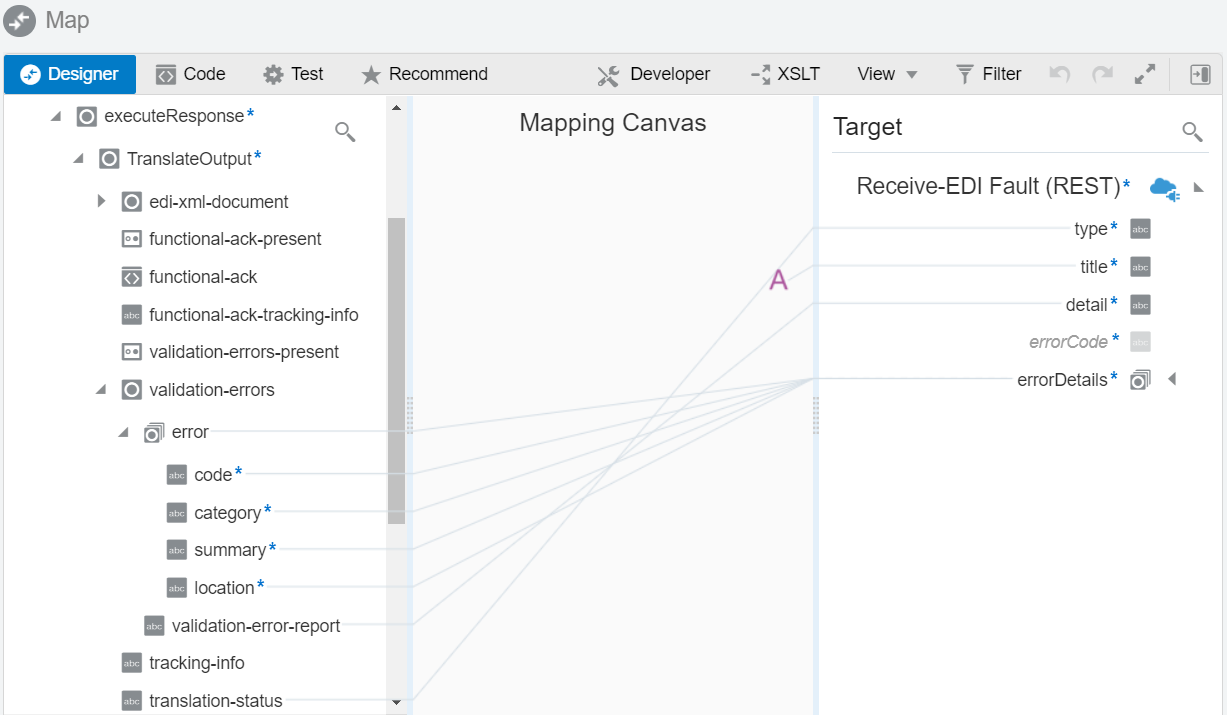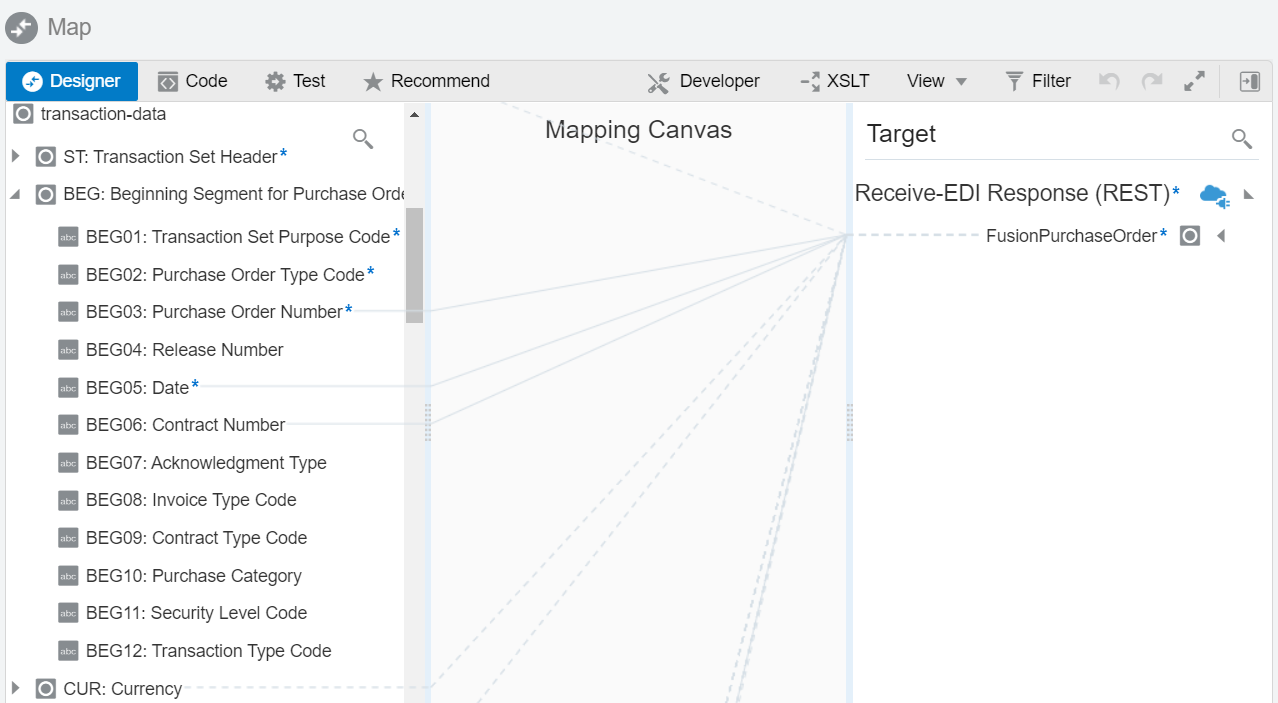You can parse and transform an EDI message to match the XML format that a
backend application can understand. The previous sections in this chapter described how to
create a basic inbound integration using the B2B action. This section describes how to
modify that integration to include a transformation step.
The previous integration returned the EDI-XML content directly in the REST Adapter response. This use case changes the REST Adapter response schema to return a FusionPurchaseOrder, a mock backend application
schema for a purchase order. Because there is no real backend application to
contact, the XML message is returned to the caller. To make this integration more
useful, you can modify it further to add an adapter invoke connection that sends the
transformed message to a backend application. Once you do that, you have an
end-to-end purchase order flow.
Error handling is also introduced in the integration. When an EDI
translation fails, an error is returned instead of transforming it to a backend
message.
This use case is described in high-level steps below. It handles an input containing a single EDI document. To handle an EDI batch file, see Process an Inbound EDI Batch File Using the Stage File Action.
Perform the following changes to the integration created in the previous section:
- Change the response schema in the Receive-EDI action (the REST Adapter trigger) created in Configure the REST Adapter Trigger Connection.
- Click the Receive-EDI element and select Edit.
- Go to the Response tab.
- Select XML Schema as the response payload format and XML as the media type.
- For the Schema Location, upload an
.xsd file with the following content:<?xml version="1.0" encoding="UTF-8"?>
<schema xmlns="http://www.w3.org/2001/XMLSchema" targetNamespace="http://www.example.org/PurchaseOrder" xmlns:tns="http://www.example.org/PurchaseOrder" elementFormDefault="qualified">
<element name="FusionPurchaseOrder"
type="tns:FusionPurchaseOrderType">
</element>
<complexType name="FusionPurchaseOrderType">
<sequence>
<element name="SenderId" type="string"></element>
<element name="orderNumber" type="string"></element>
<element name="orderDate" type="dateTime"></element>
<element name="quoteID" type="string"></element>
<element name="totalAmount" type="float"></element>
<element name="currencyCode" type="string"></element>
<element name="currencyConversionRate" type="float"></element>
<element name="lineItems" type="tns:OrderLineItem" maxOccurs="unbounded" minOccurs="1"></element>
<element name="billingAddress" type="tns:Address"></element>
<element name="shippingAddress" type="tns:Address"></element>
<element name="contact" type="tns:Contact"></element>
</sequence>
</complexType>
<complexType name="OrderLineItem">
<sequence>
<element name="SKU" type="string"></element>
<element name="Quantity" type="float"></element>
<element name="unitOfMeasure" type="string"></element>
<element name="comments" type="string"></element>
<element name="price" type="float"></element>
<element name="amount" type="float"></element>
</sequence>
</complexType>
<complexType name="Address">
<sequence>
<element name="Name" type="string"></element>
<element name="AddressLine1" type="string"></element>
<element name="AddressLine2" type="string"></element>
<element name="AddressLine3" type="string"></element>
<element name="City" type="string"></element>
<element name="State" type="string"></element>
<element name="Country" type="string"></element>
<element name="ZipCode" type="string"></element>
</sequence>
</complexType>
<complexType name="Contact">
<sequence>
<element name="name" type="string"></element>
<element name="phone" type="string"></element>
<element name="email" type="string"></element>
</sequence>
</complexType>
</schema>
- Add a switch action after the EDI-Translate action.
- For the If branch, enter the following expression:
$EDI-Translate/nssrcmpr:executeResponse/nsmpr6:TranslateOutput/nsmpr6:translation-status = "Success" or $EDI-Translate/nssrcmpr:executeResponse/nsmpr6:TranslateOutput/nsmpr6:translation-status = "Warning"
Note:
Your namespace prefix may include different values than
nssrcmpr and
nsmpr6.
This expression indicates that if TranslateOutput > translation-status has a value of Success or Warning, then take this route. This is referred to as the success route.
- Call the Otherwise branch the error route for error handling.
- In the error route, add a fault return action.
This creates a map before the fault return action.
- In the map, connect the useful error information inside
TranslateOutput > validation-errors to the fault error details. See B2B Action Input and Output Schema Reference for a description of elements inside TranslateOutput.
The error route does not transform the message (or
prepare it for delivery to a backend application). Instead, it
returns a 5xx error.
- In the success route, add a message transformation step.
Message transformation is done using a map action.
- Add a map and a return action to this route.
The map has fairly complex mappings from the EDI-XML
purchase order to the FusionPurchaseOrder. Performing this mapping
requires some expertise on the target application schema and EDI X12
schema.
Elements are mapped from the X12 BEG and REF segments,
purchase order line items from the PO1 loop, and the purchase order
summary from CTT and AMT segments near the end.
Not all elements from the EDI-XML schema are mapped because the FusionPurchaseOrder schema is smaller and comparatively much simpler than the rich structure defined in the EDI X12 schema. The map transforms the EDI-XML message to a FusionPurchaseOrder message that is ready to be consumed directly by a back-end application.
- Activate the integration and use any REST client such as
postman to send the following EDI X12 850 purchase
order:
ISA|00| |00| |01|111111T |01|22222 |190312|0845|U|00401|000001894|0|T|~
GS|PO|0124578|ACME|20190312|084515|0123456|X|004010
ST|850|1234
BEG|00|NE|PO-4503000||20190312|QO-1032
CUR|2L|USD|1.0000
REF|IT|999|Global Chips
REF|WO|P8923.5
REF|KY||Standard Terms and conditions will apply
PER|BD|JAMES SMITH|TE|1112223333|EM|jamess@globalchips.com
FOB|PC|OR|ORIGIN FREIGHT COLLECT|02|FOB
ITD||3|||||10|||||P03R
DTM|002|20190329
TD5|B||05||Ground
N1|BT|Global Chips
N2|ACCOUNTS PAYABLE
N3|P.O. BOX 1111
N4|NEW YORK|NY|10001|US
PO1|00001|1|EA|74.99|PE|BP|5566|VN|AB-1264
PID|F||||AB-1264 BRACKET ASSY WITH SPRING
PO1|00002|1|EA|25.00|PE|BP|7264|VN|DE-1834
PID|F||||DE-1834 GEAR BOX PACKAGE
CTT|2|2
AMT|TT|99.99
SE|22|1234
GE|1|0123456
IEA|1|000001894
You receive a response with the following XML message:
<tns:FusionPurchaseOrder xmlns:tns="http://www.example.org/PurchaseOrder">
<tns:SenderId>111111T</tns:SenderId>
<tns:orderNumber>PO-4503000</tns:orderNumber>
<tns:orderDate>20190312</tns:orderDate>
<tns:quoteID>QO-1032</tns:quoteID>
<tns:totalAmount>99.99</tns:totalAmount>
<tns:currencyCode>USD</tns:currencyCode>
<tns:currencyConversionRate>1.0000</tns:currencyConversionRate>
<tns:lineItems>
<tns:SKU>AB-1264</tns:SKU>
<tns:Quantity>1</tns:Quantity>
<tns:unitOfMeasure>EA</tns:unitOfMeasure>
<tns:comments>AB-1264 BRACKET ASSY WITH SPRING</tns:comments>
<tns:price>74.99</tns:price>
</tns:lineItems>
<tns:lineItems>
<tns:SKU>DE-1834</tns:SKU>
<tns:Quantity>1</tns:Quantity>
<tns:unitOfMeasure>EA</tns:unitOfMeasure>
<tns:comments>DE-1834 GEAR BOX PACKAGE</tns:comments>
<tns:price>25.00</tns:price>
</tns:lineItems>
<tns:billingAddress>
<tns:Name>Global Chips</tns:Name>
<tns:AddressLine1>ACCOUNTS PAYABLE</tns:AddressLine1>
<tns:AddressLine2>P.O. BOX 1111</tns:AddressLine2>
<tns:AddressLine3/>
<tns:City>NEW YORK</tns:City>
<tns:State>NY</tns:State>
<tns:Country>US</tns:Country>
<tns:ZipCode>10001</tns:ZipCode>
</tns:billingAddress>
<tns:contact>
<tns:name>JAMES SMITH</tns:name>
<tns:phone>1112223333</tns:phone>
</tns:contact>
</tns:FusionPurchaseOrder>
- To test a negative case, modify line 1 and replace
ISA with
any other characters, and submit. This causes the integration to take the error
route. An HTTP Error 500 is returned with an error message,
including this inner error:B2B-01858: Not an EDI X12 native document since the first
3 characters are not 'ISA' (found: 'SDS')
In conclusion, you can use Oracle Integration to accept an inbound EDI message, parse it, check for syntax errors in the EDI,
transform it, and send it to a backend application.


